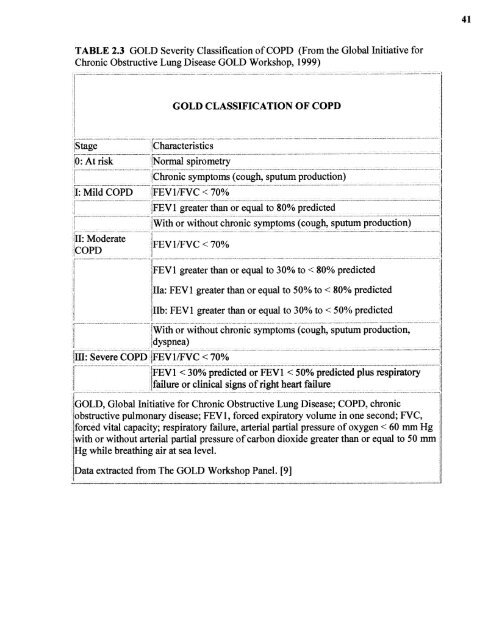njit-etd2003-081 - New Jersey Institute of Technology
njit-etd2003-081 - New Jersey Institute of Technology njit-etd2003-081 - New Jersey Institute of Technology
41 TABLE 2.3 GOLD Severity Classification of COPD (From the Global Initiative for Chronic Obstructive 'limo Disease GOT .D Workshop, 1999) GOLD, Global Initiative for Chronic Obstructive Lung Disease; COPD, chronic obstructive pulmonary disease; FEV1, forced expiratory volume in one second; FVC, forced vital capacity; respiratory failure, arterial partial pressure of oxygen < 60 mm Hg with or without arterial partial pressure of carbon dioxide greater than or equal to 50 mm Hg while breathing air at sea level. Data extracted from The GOLD Workshop Panel. [9]
CHAPTER 3 ENGINEERING BACKGROUND The transformation of the electrocardiogram, blood pressure and respiration signals into heart rate variability, blood pressure variability and respiration spectra requires many intermediate steps such as peak detection, interpolation, resampling and spectral analysis. To date, there are no standardized ways to process this data to study heart rate variability, blood pressure variability, and respiration. This leads to varying experimental results and difficulties in the comparison of the experimental results from one research facility to another. The purpose of this chapter is to introduce a brief background of various signalprocessing methods used in this dissertation. First, a brief introduction to timefrequency distributions is presented. The uncertainty principle, the concepts of analytic signal, instantaneous frequency and the desired properties of the time-frequency distribution are discussed. The importance of covariance and invariance notion of the density function as an operator in the time-frequency distribution is mentioned. A brief theoretical background comparison of the short time Fourier transform, Wigner, windowed Wigner, Choi-Williams distributions and wavelets are discussed. Other methods of analysis including spectral analyses of HRV and BPV are also presented. The concepts of the cross-spectral analysis (coherence, weighted coherence, and partial coherence) and system identification are covered. Finally, the classification technique using principal component analysis and cluster analysis are also presented in detail. 42
- Page 19 and 20: TABLE OF CONTENTS (Continued) Chapt
- Page 21 and 22: LIST OF FIGURES Figure Page 2.1 The
- Page 23 and 24: LIST OF FIGURES (Continued) Figure
- Page 25 and 26: LIST OF FIGURES (Continued) Figure
- Page 27 and 28: ABBREVIATIONS A ABP Arterial Blood
- Page 29 and 30: ABBREVIATIONS (Continued) P PID Pro
- Page 31 and 32: 2 mortality and sudden death. [2] B
- Page 33 and 34: 4 1) Patients with severe pulmonary
- Page 35 and 36: 6 examined for determining the inte
- Page 37 and 38: 8 identified using principal compon
- Page 39 and 40: 1 0 1. Present the application of t
- Page 41 and 42: 12 1.3 Outline of the Dissertation
- Page 43 and 44: CHAPTER 2 PHYSIOLOGY BACKGROUND Bio
- Page 45 and 46: 16 Figure 2.2 The systemic and pulm
- Page 47 and 48: 18 illustrated in Figure 2.3. The i
- Page 49 and 50: 20 2.2 Blood Pressure The force tha
- Page 51 and 52: 22 2.4 The Nervous System Human beh
- Page 53 and 54: 24 The sympathetic nerve fibers lea
- Page 55 and 56: 26 Without these sympathetic and pa
- Page 57 and 58: 28 center in the medulla, which con
- Page 59 and 60: 30 Figure 2.6 Autonomic innervation
- Page 61 and 62: 32 average heart rate was measured
- Page 63 and 64: 34 However, they do note that there
- Page 65 and 66: Figure 2.9 The placement of the pos
- Page 67 and 68: 38 female. While more men suffer fr
- Page 69: 40 Stage II: Moderate COPD - Worsen
- Page 73 and 74: 44 Two common types of time-frequen
- Page 75 and 76: 46 STFT: Short-Time Fourier Transfo
- Page 77 and 78: 48 3.3 The Analytic Signal and Inst
- Page 79 and 80: 50 The advantage of using equation
- Page 81 and 82: 52 3.5 Covariance and Invariance Th
- Page 83 and 84: where H(f), S(f) are Fourier transf
- Page 85 and 86: 56 Another shortcoming of the spect
- Page 87 and 88: 58 should take the kernel of the WD
- Page 89 and 90: 60 called the cross Wigner distribu
- Page 91 and 92: 62 3.6.3 The Choi-Williams (Exponen
- Page 93 and 94: 64 Figure 3.3 Performance of the Ch
- Page 95 and 96: 66 [-Ω,Ω ], then its STFT will be
- Page 97 and 98: 68 This condition forces that the w
- Page 99 and 100: 70 where c is a constant. Thus, the
- Page 101 and 102: Figure 3.5 The time-frequency plane
- Page 103 and 104: 74 The measure dadb used in the tra
- Page 105 and 106: 76 and the wavelet transform repres
- Page 107 and 108: 78 Figure 3.6 Figure depicting the
- Page 109 and 110: 80 The final step to obtain the pow
- Page 111 and 112: 82 It should be noted that if the w
- Page 113 and 114: 84 The normal respiration rate can
- Page 115 and 116: Figure 3.12 Power spectrum of BP II
- Page 117 and 118: RR similar manner to give: When com
- Page 119 and 120: 90 when there is significant correl
41<br />
TABLE 2.3 GOLD Severity Classification <strong>of</strong> COPD (From the Global Initiative for<br />
Chronic Obstructive 'limo Disease GOT .D Workshop, 1999)<br />
GOLD, Global Initiative for Chronic Obstructive Lung Disease; COPD, chronic<br />
obstructive pulmonary disease; FEV1, forced expiratory volume in one second; FVC,<br />
forced vital capacity; respiratory failure, arterial partial pressure <strong>of</strong> oxygen < 60 mm Hg<br />
with or without arterial partial pressure <strong>of</strong> carbon dioxide greater than or equal to 50 mm<br />
Hg while breathing air at sea level.<br />
Data extracted from The GOLD Workshop Panel. [9]



